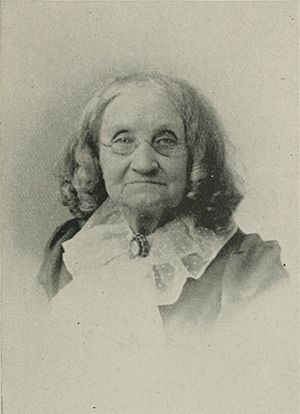Catherine Swan Brown Spear facts for kids
Quick facts for kids
Catherine Swan Brown Spear
|
|
|---|---|

Catherine Swan Brown Spear in A Woman of the Century (1893)
|
|
| Born |
Catherine Swan
6 August 1813 |
| Died | 29 June 1903 |
| Resting place | Cedar Lawn Cemetery, Paterson, Passaic County, New Jersey, USA |
| Occupation | Reformer, abolitionist, educator |
| Movement | Abolitionism, Temperance, Prison reform |
| Spouse(s) | Abel Brown (d. 1844); Charles Spear (d. 1863) |
Catherine Swan Brown Spear (born August 6, 1813 – died June 29, 1903) was an important American woman. She worked to make society better as a reformer, a teacher, and an abolitionist.
Contents
Early Life and Education
Catherine Swan was born in Worcester County, Massachusetts, on August 6, 1813. She was the oldest of seven children. Her parents, Samuel Swan and Clara Hale, were both teachers.
Catherine started school when she was just three years old. She continued her education until she was 18. After finishing school, she worked as a teacher for three years.
Fighting for Change
Catherine became involved in the anti-slavery movement at age 19. This movement worked to end slavery in the United States.
Marriage and Abolitionism
In 1843, Catherine Swan married Abel Brown. He was also an abolitionist. They met when Abel was giving anti-slavery speeches in Massachusetts.
Catherine became known for speaking and singing anti-slavery songs. She often joined her husband on his trips. People said she had a beautiful voice.
The couple traveled widely to support the abolitionist and temperance movements. The temperance movement worked to reduce or stop the use of alcohol. They also helped enslaved people escape to freedom.
Catherine later wrote about their beliefs. She said they believed in a "higher law" than human laws. This meant they helped people even if it went against laws that supported slavery.
Sadly, Abel Brown died after only 18 months of marriage. Catherine was pregnant at the time. She named her child Abel. In 1849, she wrote a book about her husband's life. She hoped it would inspire others to work hard for what they believed in.
A New Partnership
In 1855, Catherine married her second husband, Reverend Charles Spear. He was a minister and reformer from Boston. Charles Spear was known as "the prisoner's friend."
Catherine and Charles visited many prisons together. This made Catherine very interested in prison reform. She wanted to make prisons more humane and help people who had been in jail.
Catherine continued to work for the temperance movement. She also supported women's rights and the right for women to vote. She and Charles worked together to change laws about punishment. They believed in helping people instead of just punishing them.
Work During the Civil War
Even though Catherine believed in peace, she felt the American Civil War was necessary. During the war, she worked in hospitals. Her husband, Charles Spear, was a chaplain in Washington, D.C..
Charles Spear died in 1863. However, Catherine stayed in Washington until the war ended. She continued her important work helping others.
Later Years
After the war, Catherine moved to Passaic, New Jersey. She lived there until her death on June 29, 1903.

